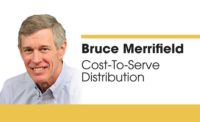After World War II, when the economy tanked, the drill was to freeze hiring, maybe weed out a few, freeze all investments, cut all discretionary expenses and try not to cave on declining incentive pay that is de facto salary. Basically, wait out the recession, then get back to growing with the U.S. economy; your industry; and/or the inflation in your product lines.
Today, we face an unprecedented global-economy due to the COVID-19 shutdown or pause. This is favoring “digital disruptors” focused on stealing sales from traditional distribution channels. Next-gen millennial buyers are being more conditioned to expect more digital capabilities and (B2B) buying scenarios (vs. dealing through regular calling reps).
How can distributors simultaneously downsize, upgrade and reinvent what they are doing?
A DOWNSIZE-UPGRADE CASE
A distributor roll-up had plenty of debt and a new, profitless branch with six trucks rolling out every day. Statistics revealed that it had a huge opportunity:
- Fifty percent of the active accounts generated only 5% of the gross margin dollars on 25% of the warehouse transactions/deliveries for a net-loss; and
- This sub-group of customers was using the equivalent of the full-capacity of two trucks, drivers, warehouse folks and inside sales reps (six people total). The full cost of the trucks plus the six was more than twice the contributed margin dollars from all 50%.
As an experiment, a letter was sent to the worst half of the 50% (which generated only 1% of the gross margin dollars) declaring new (profitable) terms. Then, the declining order activity was tracked from order consolidations; new will calls (vs. free delivery) and defecting customers. Ten of the 50% appeared to have switched to paralyzed competitors. The rest bought in a new and profitable way.
As the transactional activity dropped, the least-productive trucks and people were laid off. Remaining employees received “productivity increase” raises. Profits improved dramatically and sales started to climb since fewer, better employees had the breathing room to take better care of the fewer, but better customers.
The moral is: Don’t cut costs across the board; use focused, net-profit-analytics surgery.
INVENT SERVICE VALUE, THEN FIX MINNOWS
Here’s one better: A distributor team walked through its No. 1 net-profitable customer’s plant looking for inefficiencies in product flow and usage, communications, etc. The team identified 15 small fixes which they provided for free. New spend was identified, asked for and won. Sales for the account doubled, average order size increased by 20% and net-profits tripled, but transactional activity increased by 60%. Hire more people?
No! Headcount had been frozen. The new “innovation metrics” were to grow gross margin dollars, operating profit dollars and gainsharing bonus dollars per employee. Instead of new hires, they did a minnow program. Sales, rebates, profits and gainsharing all grew, so all stakeholders won!



